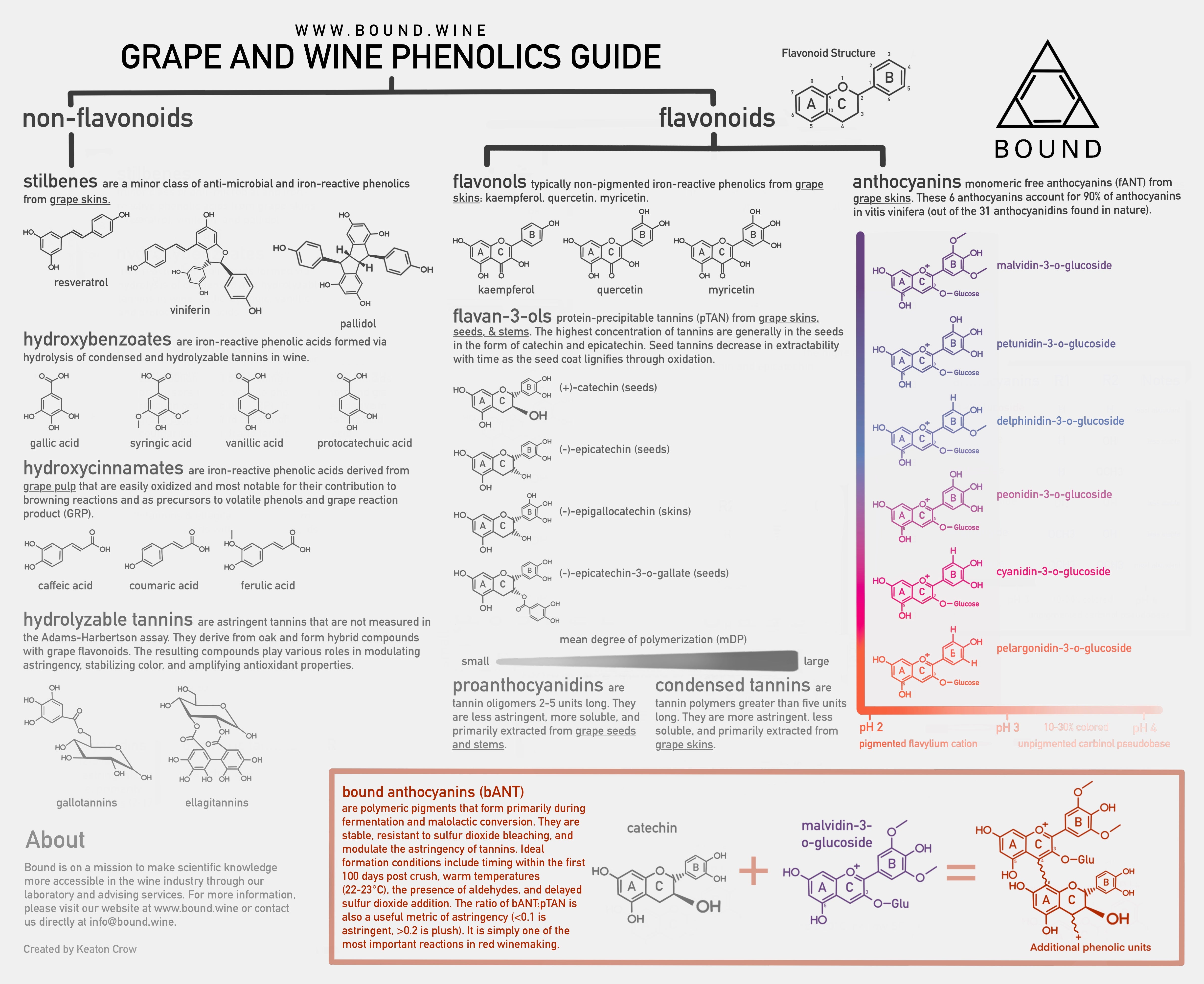

pTAN:IRPs
The Protein-Precipitable Tannins to Iron-Reactive Phenolics ratio (pTAN:IRP) is a useful metric for understanding extraction in skin-macerated wines. Iron-Reactive Phenolics extract readily from grape pulp whereas Protein-Precipitable Tannins require alcohol, temperature, and movements to extract from the skins and seeds. Because of this, high production wines tend to have lower ratios whereas reserve-tier wines generally have higher ratios. pTAN generally account for 50-55% of extractable IRPs in skin-macerated wines. This ratio will fluctuate depending on fruit quality, most notably decreasing with hotter climates.
Protein-Precipitable Tannins: Iron-Reactive Phenolics (pTAN:IRPs)
-
<0.3 is low-efficiency extraction typical of shorter macerations and larger production volumes.
-
3-0.4 is a moderately efficient extraction typical of middle-tier wines.
-
4-0.5 is a highly efficient extraction typical of premium and reserve wines.
-
>0.5 is heavily extracted typical of powerful wines.
For winemakers, these ratios are particularly useful for monitoring adherence to protocols and understanding the performance of vineyards across multiple vintages. We generally don’t place value between higher or lower ratios as a sign of quality, rather, we focus on pTAN:IRP as an indicator of extraction. Lower ratios benefit more delicate wine styles whereas high ratios benefit more concentrated wine styles. We can use the following variables to steer the type of extraction we desire based on the qualities of our fruit.
To learn more about the pTAN:IRPs ratio and how it applies to winemaking, become a Bound advising client.
Choose options


FAQs
Frequently Asked Questions
Supplies
- Centrifuge Tubes (SKU: G1005-50-2)
- Blank Label Sheets
- Label Template (Download)
- We supply 50 mL centrifuge tubes and labels for local Santa Barbara clients upon request.
Best Practices
- Collect a sample of your wine in a way that is most representative of the entire lot (i.e. practice flushing your sample valve, collecting after movements like pumpovers, stirring your barrel, etc.).
Label
- Label each sample appropriately with your Client ID, Sample Date, and Sample ID. Samples for Phenolics analysis also require a Crush Date, Varietal, and Appellation. The analysis cannot be performed without the applicable information for each sample.
- Mark the panel.
- Individual parameters can be added at the bottom of the label. A full list can be found on our ANALYSES page.
Clients are able to submit samples by contacting us directly and scheduling a pickup, delivering directly to our lab, or sending via the mail.
To arrange for pickup, clients must be located near Lompoc, Buellton, Santa Ynez, Goleta, or Santa Barbara and notify us by 11 am for same-day retrieval. Please contact us for more information.
- We provide same-day results by 7 pm with a guaranteed turnaround within 24 hours of sample receipt.
- Samples that are not analyzed same-daly are refrigerated overnight and analyzed first thing the next morning.
- Results are delivered via email in PDF format and uploaded to your account.
- Our invoices are sent via email and are due upon receipt.
- Your payment iOur invoices are sent via email and are due upon receipt.
- Your payment is securely processed through Bound’s website using one of the most trusted e-commerce platforms in the world.
- You can also opt-in to our invoice autopay feature.s securely processed through Bound’s website using one of the most trusted e-commerce platforms in the world.
- You can also opt-in to our invoice autopay feature by clicking “SIGN UP FOR AUTOPAY” on your account page.
To ensure their stability, we ask our clients freeze their juice samples before shipment. Please contact Bound with any additional questions about sample preparation before shipment. We recommend expedited same-day to one-day shipping with a tracking number included.
Frozen
Samples can be placed in a freezer 24-hours in advance and shipped with an ice pack. Do not over-fill the polypropylene tubes or use glass containers as the frozen liquid will expand and could pose a safety concern. Freezing samples is a better alternative to boiling when analyzing compounds like ethanol, volatile acidity, free sulfur, and phenolics. Label each sample as "FROZEN".

